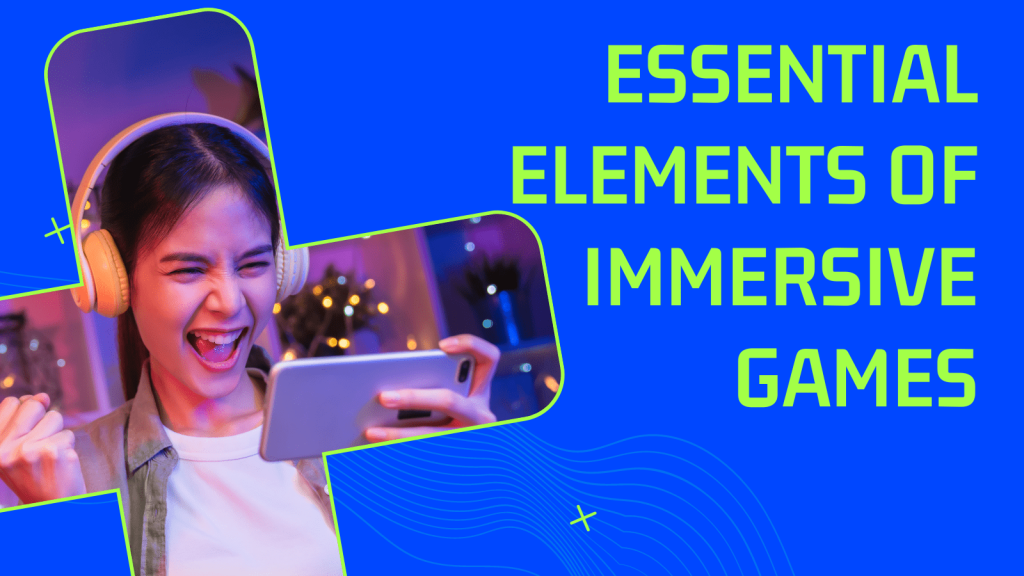
Engaging gameplays follow certain design principles to build an entertaining experience that entices players to return again and again. The application of these principles through the essential elements into game apps creates a repetitive sequence of anticipation & reward which is at the core of any multimedia game design. The better the orchestration of these sequences the more immersive the game is. Here are the essential elements of gameplay that make compelling games.
A better Design Interactivity
A game’s ability to engage a player with immersive experiences demonstrates effective design interactivity. It is a set of features designed to make the player experience the story, mechanics, and environment of the game. Good interactivity detaches players from the real world and immerses them in a fantasy world that gives them sensory and emotional gratification.
Centering interaction around the primary set of features of the game makes it more engaging. For example, if the game involves target shooting the primary feature is shooting, and the interactivity can be improved by introducing different types of guns and special powers to use while shooting. This advancement to the primary feature of the game increases the interaction of the player with the feature.
Design interactivity may be physical, intellectual, or emotional. Physical interaction includes tapping buttons or precisely grasping the skills to physically control the game. Intellectual interactivity includes using the brain, i.e strategy to play the game, for example, puzzle games and strategy games. Emotional interactivity refers to interaction with the characters, stories, or any factors which indulge emotions or involve emotional involvement.
A seemingly epic challenge
Challenge motivates action and generates the urge to struggle to achieve an actionable goal. The challenge is the ultimate motivational driver and the bigger the challenge, the greater the gratification of winning.

Challenges in themselves may not be epic in the true sense, but they should provide a thrilling experience toward a goal. A well-designed challenge to accomplish a seemingly epic goal produces the highest anticipation and engagement and provides an entertaining experience. Multiplayer mobile games, for example, involve real-time competition between players who are all working towards the same goal. The “sense of achievement upon winning” drives the motivation to compete and that makes the challenge epic.
Constraints – Motivating Stakes
Constraints make the game actions more challenging by reducing ease and freedom while keeping the scope for a reward. Constraints in gaming refer to deadlines, ticking clocks, timebound actions, goal completion with limited powers, periodic hindrances, difficult-to-traverse paths, etc. Constraints are essential components of gaming, providing structure, challenge, and excitement to the gameplay experience.
Constraints create more highs and lows in the game dynamics which bring anticipation and excitement among players by posing as motivating stakes. They add a sense of undertaking calculated and careful actions while progressing through the game making the gameplay more engaging and stimulating. This can help to keep players interested and invested in the game, and also provide a sense of accomplishment when they complete a task or level within the constraints.
Setups & Achievable Payoffs
Continual sequences of setups and payoffs are an effective tool to keep the players on the edge and hooked to the game. Setups are elements of a game that introduce a challenge or obstacle to the player. This can include enemies, puzzles, or difficult levels that the player must overcome to progress through the game. By setting up these challenges, the player is invested in the outcome and motivated to complete the task.
Payoffs are any form of satisfactory ending that the player experiences after successfully interacting with the setup. This can include unlocking new levels, gaining access to new characters or items, or earning in-game currency or rewards. By providing a payoff, the player feels a sense of accomplishment and satisfaction, which encourages them to continue playing the game.
Taking players through the order of challenge, accomplishment, and reward repetitively conditions them to immerse into the game every time they return to play it.
An Efficient Engagement Loop
Engagement loops are necessary for mobile games to keep the players’ anticipation alive throughout the game. They provide users a sense of progression in multiple contexts like motivation, rewards, or incentives to keep playing, making it more likely that they will stay engaged with the game.
An example of how an engagement loop operates:
- The player starts the game and engages with the gameplay.
- They receive a task (actionable goal) that promises a gratifying outcome or a reward.
- They act on it and complete it.
- They are satisfied and anticipate more such tasks.
This cycle of actions and rewards is designed to provide users with a sense of gratification. They can be quests or missions, daily rewards, or random rewards. It encourages players to come back and play the game more often, which increases user engagement and makes players loyal fans of the game in the long run.
Leaderboards
Leaderboards enhance the gameplay experience in mobile games by creating a competitive, social, and rewarding environment for players.
Competitiveness: Leaderboards can add a competitive element to mobile games, encouraging players to strive for high scores or achievements to climb up the leaderboard rankings. This can motivate players to spend more time playing the game.
Social Interaction: Leaderboards can also create a sense of community among players, providing a platform that can foster social interaction leading to increased engagement and retention.
Rewards and Incentives: Some mobile games offer rewards or incentives for high-ranking players on the leaderboard, such as in-game currency, special items, or other benefits. This can motivate players to strive for higher scores and rankings, increasing engagement and encouraging them to continue playing the game.
Final Word
The essential components of immersive game apps enhance the gameplay experience in varying degrees depending upon how appropriately they are incorporated into the game. Guiding the player through a designated path, and hooking them into a never-ending series of challenges and rewards marks efficient design, and its natural consequence is engaging gameplay.

